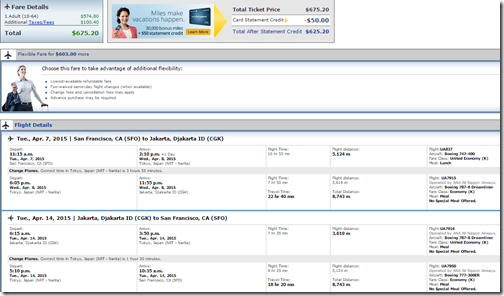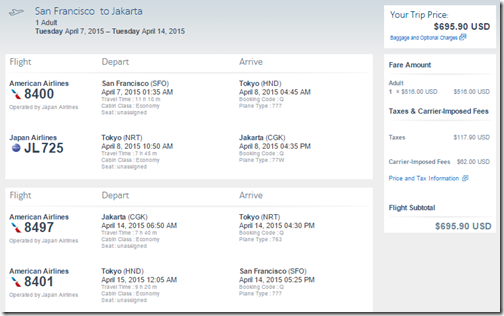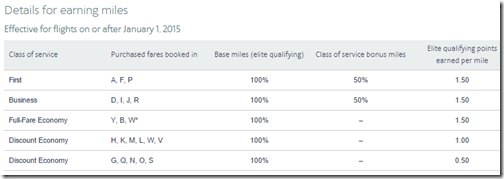There is a fare sale happening for April 2015 for San Francisco Jakarta SFO-CGK routes flying United Airlines and ANA for $676 round trip all-in or American and JAL for $696. American Airlines itinerary sucks with Tokyo airport change required for the low fare, but check out the difference in frequent flyer miles earned for these tickets. AAdvantage members earn more than 15,000 miles, while Mileage Plus members earn fewer than 3,000 miles.
This fare to Indonesia provides a good example of the difference in miles earned for United Mileage Plus revenue-based flying and American Airlines distance-based flying for roundtrip flights covering nearly 17,500 miles in flight distance.
San Francisco – Jakarta, Indonesia SFO-CGK April 7-14, 2015 $676
This itinerary SFO-NRT-CGK-NRT-SFO is 17,486 miles roundtrip. United Mileage Plus revenue-based miles earning at 5 miles per $1 for base members means the $574.80 base fare earns 2,874 frequent flyer miles.
The ticket price is the base fare plus carrier-imposed surcharges. Actual mileage posting will be determined by the actual ticket price, purchased ticket routing, fare class, ticket issue date, flight departure date and the Premier status and residency of the traveler. For tickets purchased in a currency other than U.S. dollars, we will convert the purchase to U.S. dollars and then calculate the number of miles you will earn.
JAL Japan Airlines San Francisco Jakarta, Indonesia $696 bookable on American Airlines website
This flight itinerary sucks due to a change of airports both outbound and inbound between Tokyo Narita (NRT) and Tokyo Haneda (HND). JAL Japan Airlines flight arrives at Tokyo Narita Airport NRT. The connecting JAL Japan Airlines flight to Jakarta departs from Tokyo Haneda Airport HND. This is about a 2 hour transit by train at a cost of $20 to $30 USD each way.
I have not been to Haneda Airport, but I made a transfer from London Gatwick to London Heathrow a few months ago and it took several hours to travel between the two airports cheaply. Pay more and there is a shuttle bus express between LHR and LGW in about 90 minutes travel time.
Tokyo and Haneda are about 90 minutes apart by train. Haneda Airport HND link about transportation to Narita Airport NRT.
$1.00 USD = 120 Japan Yen is about accurate based on current exchange rates.
Please leave a comment about Narita-Haneda airport transfers and help less informed travelers like me.
There were itineraries available with an all-day layover or an overnight transit layover in Japan at no additional cost.
My primary purpose here for showing American Airlines routing is to compare frequent flyer miles earned with AAdvantage on this ticket compared to United Airlines.
American Airlines AAdvantage flight distance determines miles earned for this ticket.
Great Circle Mapper calculates the flight distance at 8,780 miles each way.
17,560 miles round trip flight distance in Q booking class earns 100% miles with American AAdvantage.
Earn elite-qualifying AAdvantage miles when you fly on American Airlines and American Eagle flights as well as American or American Eagle codeshare flights operated by other airlines.
Three of the four flight segments are marketed as American Airlines codeshares and earn 100% miles for booking code Q. Japan Airlines is marketed and operated as OneWorld partner for outbound segment between Japan and Indonesia. That segment earns 30% base miles according to American AAdvantage chart for Japan Airlines.
JAL non-codeshare flight NRT-CGK = 3,620 miles reduced to 30% miles = 1,086 miles.
These American marketed and JAL operated flights earn a total 15,026 miles.
- United Airlines and ANA flights are $676 for SFO-CGK and earn 2,874 Mileage Plus miles. Better flight itinerary.
- American Airlines marketed Japan Airlines flights are $696 for SFO-CGK and earn 15,026 AAdvantage miles. Lousy flight itinerary, but lots of miles.
Where is your frequent flyer loyalty for 2015?
[Note: This was a more complicated itinerary than desirable using an American Airlines booked ticket for Japan Airlines flights for this kind of miles earning comparison to United ticketing on a long-haul international tickets. Please let me know if you see calculation errors for miles earning.]






14 Comments
Comments are closed.